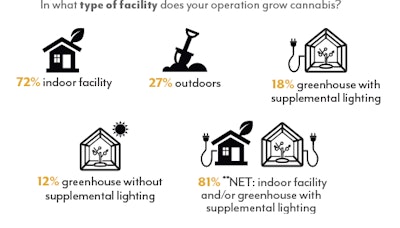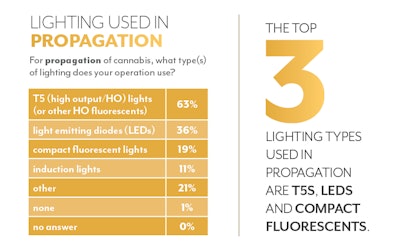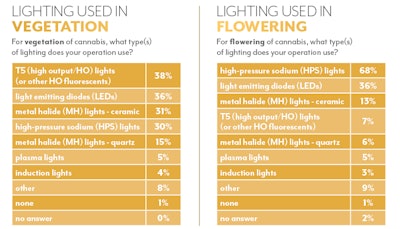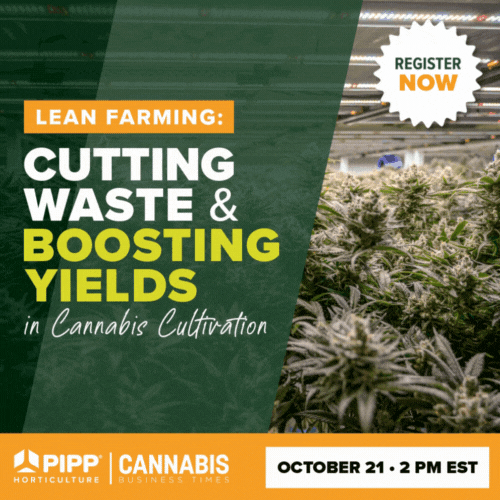
One of the biggest issues surrounding lighting is not only which type of lighting cultivators use, but which type they use at various cannabis growth stages. Often, they use two or three types of lighting during different stages of production, and may be testing a third or fourth type in other grow rooms or greenhouse areas. Conventionally speaking, high intensity discharge lights (metal halide (MH) and high-pressure sodium (HPS)) were noted as the gold standard used by growers. Today presents a slightly different picture.
While MH (ceramic and/or quartz combined) still ranks at the top of the list of lights used by cultivators in the vegetative stage (43% of research participants said they use MH in this growth stage), the margins are slim against other lighting options.
T5 (high output/HO) lights (or other HO fluorescents) are the second-most commonly used type of lighting in the veg state, with 38% of cultivators who participated in CBT’s research saying they use T5s. (Research participants were able to select all types of lighting they used during each growth stage, and the numbers suggest that many growers use multiple types of lighting.)

Right behind T5s, by just a 2% margin (at 36%), are light emitting diodes (LEDs), which at one time were considered a novelty, largely due to expense (and in part due to their unfamiliarity among growers). But as far back as 2015, WIRED magazine wrote, “LEDs, for their part, have recently gotten cheap enough to be more than a novelty.”
HPS lights ranked fourth among cultivators in the study—for the veg stage—with a 30% usage rate, also a relatively small margin behind MH, T5s and LEDs.

When it comes to the flowering stage, however, HPS came in as the most commonly used type of lighting, with more than two-thirds (68%) of research participants indicating they use HPS lights.
LEDs ranked as the second-most commonly used lights during flowering, selected by more than a third (36%) of growers, exceeding usage of MH by nearly 20 percentage points (with 17% indicating they use MH lights during this growth stage).
For propagation, the largest percentage of cultivators said they use T5s (63%), followed by LEDs (36%) and compact fluorescents (19%).
LEDs were the only type of light to rank in the top three in every growth stage. But while they seem to have shed their novelty status, the entire market isn’t quite ready to fully commit to LEDs. Among the research participants who said they don’t use LEDs in flowering, 44% said they are not planning to use LEDs in the cannabis flowering cycle in the next 12 months. Nearly a quarter (22%), however, said they do plan to use LEDs in flower in the year ahead, while 34% remain unsure.















